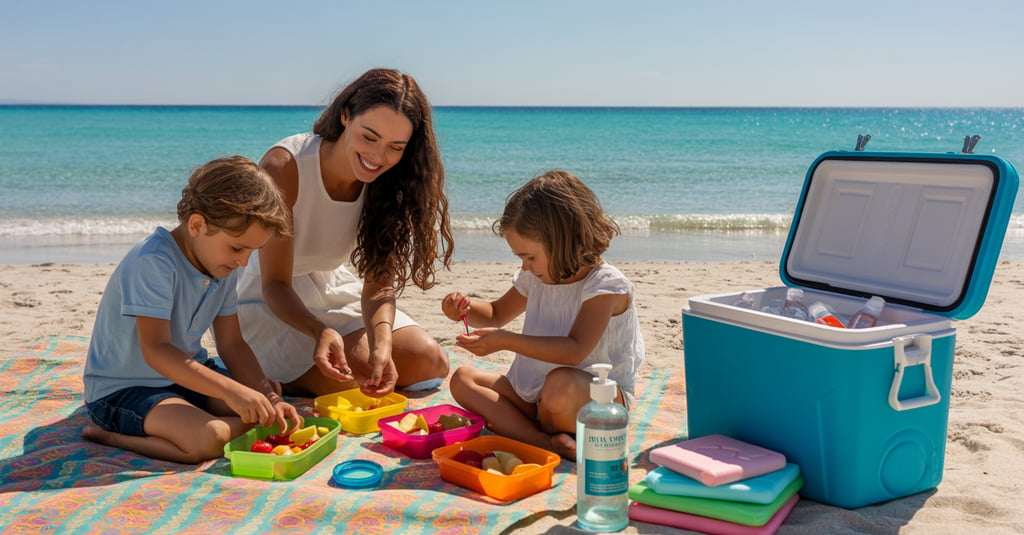Food Safety - For Parents: Keeping Little Tummies Safe at the Beach
Spending a day at the beach with children is one of summer's greatest pleasures. Sandcastles, waves, sun, and laughter all make for lasting memories. But amidst the joy, parents have an important role to play in ensuring their little ones stay healthy and safe-especially when it comes to the food they eat. The hot sun, lack of refrigeration, and potential contamination sources can turn a fun picnic into a health hazard if not carefully managed. This guide will walk you through essential food safety tips tailored specifically for families spending the day by the sea.
6/15/20253 min read


1. Why Food Safety Matters at the Beach
Beach environments present unique challenges to food safety. High temperatures accelerate bacterial growth, and the presence of sand, water, and wildlife increases the risk of contamination. Children, with their underdeveloped immune systems, are more susceptible to foodborne illnesses. Symptoms like vomiting, diarrhea, and fever can quickly ruin a family outing and lead to more serious health concerns.
Keeping food safe at the beach is about more than avoiding spoiled sandwiches; it’s about protecting your child’s health.
2. Plan: Smart Food Choices for the Beach
Before you pack, consider foods that are less likely to spoil in the heat. Avoid dishes with mayonnaise, dairy, or raw ingredients. Instead, opt for:
Whole fruits (bananas, apples, oranges)
Pre-cut veggies (carrots, cucumbers, bell peppers) stored in sealed containers
Nut butters and crackers
Hard cheeses like cheddar
Sandwiches with shelf-stable fillings (e.g., nut butter and jam)
Pre-cooked and cooled grilled chicken
Also, consider investing in reusable ice packs and a high-quality insulated cooler. Packing food in layers with the coldest items on top and bottom helps maintain temperature.
3. Safe Packing and Transport Tips
Cooler prep: Chill your cooler before use and fill it to capacity to keep contents cold longer.
Separate coolers: Use one for drinks and snacks and another for perishable items. Frequent opening allows warm air in.
Frozen water bottles: Double as both ice packs and drinks later in the day.
Label containers: Clearly mark foods for kids, especially if they have allergies.
Transport food directly from the refrigerator to the cooler and avoid letting it sit at room temperature before departure.
4. Hygiene on the Go
Handwashing may be a challenge at the beach, but it’s crucial to reduce germ spread:
Hand sanitizers: Keep a few travel-size bottles in your bag.
Wipes: Use them to clean hands and surfaces before eating.
Portable water: Bring a jug of clean water, soap, and a small basin for a quick handwash station.
Clean towels: Pack extra for drying hands and utensils.
Teach your kids to avoid touching food with sandy hands and always clean up before meals.
5. Keeping Cold Foods Cold
Cold foods should be kept below 40°F (4°C) to prevent bacterial growth. Here’s how:
Layering: Place ice packs on the top, bottom, and between food layers.
Shade: Keep the cooler in a shaded spot, covered with a towel or beach umbrella.
No peeking: Limit cooler access to keep internal temperature stable.
Use a thermometer: Some coolers come with built-in thermometers, or you can add your own to monitor temps.
Foods left out for more than 2 hours (or 1 hour if the temperature is above 90°F (32oC)). should be discarded.
6. Safe Snacks for Small Hands
Little ones love to grab and go. Offer snacks that are individually packed or easy to portion:
Mini rice cakes
Raisins or dried fruits in single-serve packs
String cheese
Small yogurt tubes (kept cold)
Hummus in sealed cups with veggie sticks
Homemade trail mix (avoid nuts for younger children)
Avoid anything that melts easily, like chocolate or cream-based items.
7. Beware of Cross-Contamination
When sand, water, and raw foods meet, bacteria can spread quickly:
Use separate utensils for raw and cooked items.
Store raw meats in leak-proof containers at the bottom of the cooler.
Avoid reusable plastic bags that are hard to clean thoroughly.
Bring extra utensils and cutting boards if prepping on-site.
8. Drink Up: Safe Hydration
Kids can get dehydrated quickly in the sun. Ensure plenty of safe drinking options:
Water: Bring more than you think you need.
Electrolyte drinks: For active kids, these can help replenish minerals.
No shared bottles: Give each child their own to avoid germ spread.
Avoid sugary drinks: These can cause stomach upset and don’t hydrate effectively.
9. Clean-Up and Waste Disposal
Good food safety doesn’t stop after eating:
Seal leftovers immediately or discard if in doubt.
Keep trash sealed to avoid attracting wildlife.
Use biodegradable wipes and eco-friendly bags where possible.
Inspect coolers at the end of the day and sanitize them before the next use.
10. Teaching Kids Food Safety
Use beach outings as learning moments:
Show them how to clean hands before meals.
Explain why some foods need to stay cold.
Involve them in packing safe snacks.
These small lessons build awareness and lifelong healthy habits.
11. What to Do If Food Poisoning Happens
Despite precautions, illness can occur. Watch for:
Nausea or vomiting
Diarrhea
Abdominal cramps
Fever
If symptoms appear, keep your child hydrated and seek medical attention if they worsen or persist. Bring a basic first-aid kit and any necessary medications with you.
A Safe Summer is a Happy Summer
Taking extra steps to ensure food safety at the beach may seem tedious, but it’s a small investment in your child’s health and your peace of mind. With smart packing, good hygiene, and a bit of planning, you can focus on what really matters: enjoying a fun, carefree day with your little ones.
Remember, a safe snack is a happy snack-especially when it comes with sandy toes and salty air!
Join us on Pinterest
letstalk@lorybs.com
© 2025. All rights reserved.
